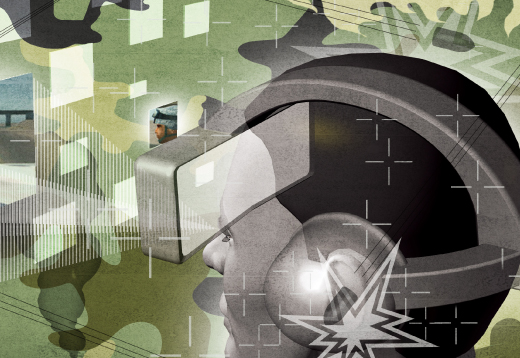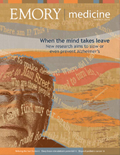Reliving the hurt locker
In the movie The Hurt Locker, Sergeant William James comes home from serving in the Middle East and struggles to re-adjust to the relative calm of everyday life. Standing in an aisle at the grocery store, he stares for a long time at endless rows of cereal boxes, overwhelmed by the magnitude of a mundane choice.
 Barbara Rothbaum says virtual reality exposure can help war veterans process troubling experiences and ease the symptoms of post-traumatic stress disorder. |
By Kay Torrance
The movie scene shows the complexity of transitioning from the battlefield to home life for veterans. They can’t sleep. They’re jumpy and irritable. They avoid public places. Often, they won’t sit with their back to a door or drive under an overpass. They fight to quash their memories of their time in Afghanistan or Iraq.
One treatment for traumatized veterans, who are often diagnosed with post-traumatic stress disorder (PTSD), takes them back to the last place they want to go, the battlefield, via virtual reality (VR). In as few as six sessions with a VR program, many veterans are getting their old life back.
The program uses a computerized Iraq scenario that is tailor-fitted to the veteran’s personal experience, says its creator, Barbara Rothbaum, director of Emory’s Trauma and Anxiety Recovery Program and a professor in the psychiatry department. The veteran wears a helmet that allows him to see and hear the video scenario, such as riding in a Humvee or walking on foot patrol. The therapist sits with a computer screen and keyboard, adding specifics that mimic what the veteran is relating of a particularly troubling incident—time of day or night, presence of smoke or fog, the smell of burning rubber or gunpowder. The veteran hears the Humvee’s motor, the voices of fellow soldiers crackling over the radio, and roadside bombs. (The scenario can give a visitor a taste of the sheer intensity of combat, with soldiers yelling in the Humvee and over the radio, helicopters flying overhead to provide air cover, guns firing, all at almost true-to-life decibel ranges.)
For many veterans who use the VR program, a roadside bomb is what “sent them to their hurt locker,” as the military saying goes. If a comrade is injured or killed, they often are swimming in survivor’s guilt.
“It’s a lousy disorder to have,” Rothbaum says of PTSD. “VR isn’t a cure for PTSD, but we can get them to the point where it doesn’t interfere with life. I tell them, ‘You can’t ever be like you were before. You’ve had a life event that’s changed you.’ They have to go back to the experience over and over but in a therapeutic way to emotionally process what happened. There is no way to the other side except through the pain.”
Veterans with PTSD often wrestle with the notion of control, says Maryrose Gerardi, an Emory psychologist who also uses the VR program. “They are told in the military, ‘If you do your job, the mission will be successful.’ One of the things that is hard to deal with for them is that they can do everything right, and bad things will still happen. They say, ‘I should have done something different.’ I’ll ask them what specifically they could have done differently in those circumstances. Often they reach their own conclusion that they did everything possible. They can honor the memory of what happened by processing it and eventually getting some peace with it.”
More than 65 veterans have been treated with VR and have had positive results. It is offered to veterans of Iraq and Afghanistan free of charge. The Department of Veteran’s Affairs and the Department of Defense also use Rothbaum’s VR for treatment of PTSD. One Navy psychiatrist took the VR program to Iraq and treated soldiers there, says Rothbaum. EM



